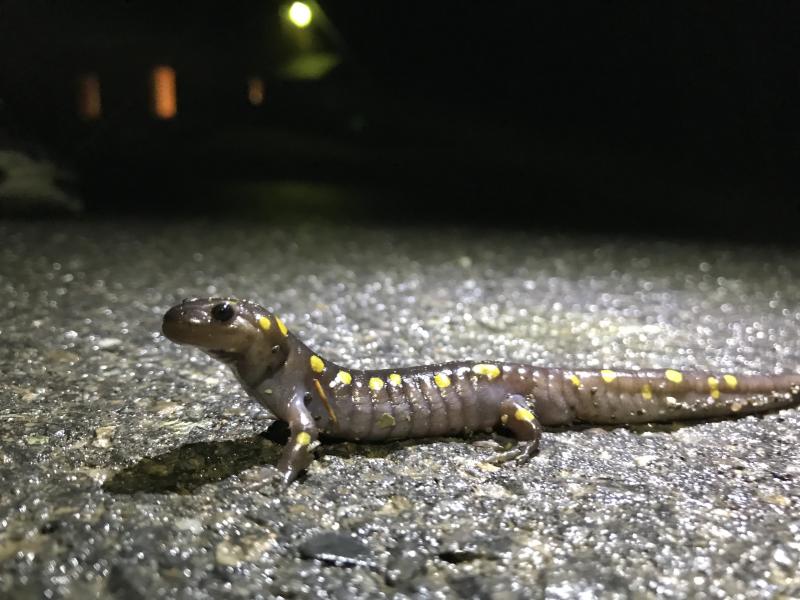There is excitement in the air as we wait for the “Big Night!” The signs are all there, snowmelt, ponds opening up, longer days, and warming temps. All we are waiting for now are the temperatures to reach the 40’s and stay there through the night combined with a heavy rainfall. Any day now…….

The Big Night has been happening in Maine, and New England, every year since the glaciers melted and the forests returned to our area. And while we still live with so much uncertainly these days, the Big Night will happen again this year likely sometime between late March – early April. What exactly is the Big Night?
The Big Night is when hundreds of thousands of amphibians will make their way out of hibernation and into surrounding vernal pools in order to find a mate and lay eggs. The majority of this miniature migration usually takes place in a single night, as mentioned earlier, when the temperatures and weather are just right. Many species of amphibians such as spring peepers, wood frogs and spotted salamanders participate in the Big Night. Local and citizen scientists have reported frenzies of amphibians crossing roads to get to their mating grounds. These amphibians lay their eggs in vernal pools, temporary stands of water, returning to the same vernal pool they hatched from.
Vernal pools are unique wetlands as they provide water without the accompanying fish due to the fact they have no freshwater source of their own but relay on snowmelt and rainfall to fill in the spring. Most vernal pools are all but dried up by late summer. With no predatory fish present vernal pools make for a safe environment for the eggs to grow in. Vernal pools in Maine are protected by law due to their importance in species survival, and therefore the ecosystem those species are a part of.
Big Night can be difficult to predict but there are clues if you pay attention. One good clue is to listen for the spring peepers. Once you hear that unmistakeable sound of early spring you can be sure the Big Night isn’t far behind on the next rainy night after a warm day. If you want to help or learn more about the Big Night here in Maine check out these links.
https://www.vernalpools.me/big-night/. This is a really good one if you want to get involved!
http://www.vernalpools.me/wp-content/uploads/2015/05/vernalpoolecology.pdf
Also, if you know of a spot in Cape Elizabeth where the Big Night is happening or where some amphibians may need help crossing the road during the big night please reach out to info@capelandtrust.org. We are hoping to learn where our local amphibians are having their big night and determine if they need a little help from some friends!
What have these amphibians have been doing all winter? Reptiles and amphibians are both cold-blooded meaning that they cannot regulate their own body temperature. Instead their body temperature is dependent on ambient air temperatures.This is why you often see tulles sunning themselves on logs, or snakes sunning themselves on a warm rock or sadly drawn to a warm asphalt road. This is all who the creatures tend to be slow and sluggish in the early morning when they have not yet warmed up yet from the cooler night temperatures. These animals have amazing adaptations for surviving a cold Maine winter. Snakes for instance will find a cave or den, ideally the same one used in years past, and go into a state of brumation where they slow their metabolism and conserve energy by limiting their movement. Turtles and toads hibernate in a manner similar to that of snakes. They will dig their way down beneath the leaf litter, under logs, below the pond, or by making dens and burrows. They also slow their metabolism to conserve energy, which is the key to survival.
Frogs such as the Spring Peeper and Wood Frog have some extraordinary methods for making it through the winter. These two species of frogs are not as efficient at burrowing into the ground as some of their relatives. If they don’t make it deep enough below the frost line they succumb to the freezing temperatures. Now comes the amazing part, when this happens their bodies virtually freeze solid and their hearts stop beating. To the naked eye these frogs appear completely frozen. Yet, their internal organs have a high concentration of glucose which serves as a sort of antifreeze and also provides essential nourishment during this time. As the sun gets higher in the sky and makes its way through the trees and temperatures rise above freezing, what seems like a little bit of magic happens when these tiny frogs essentially come back to life to find their mate.
There are several studies siting that the biomass of amphibians in a Maine forest ecosystem is greater than the combined biomass of mammals and birds in that same area. Amphibians play a major role in their ecosystems but sadly are among the most vulnerable of species as well. Urban development has been tough for amphibians and the Big Night. The development of roads often cut through the paths of amphibious migration and has lead to many of the animals getting killed. In recent years many groups have come together to help this vulnerable population. From creating tunnels under roadways for safe passage to keeping watch through the night and helping critters get safely across the road.
